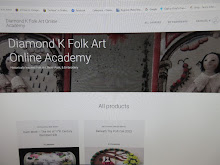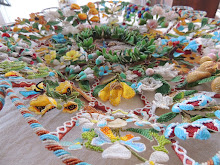
I have several scans of fashion plates of little boys in nearly the exact jacket as this one, but alas, I cannot get my disk to run....its driving me INSANE...so I went down and picked one similar, and snapped a picture for you. This original hand colored fashion plate is from La Mode, and is titled "Costume Parisiens 1831 No. 2904" In the time, this jacket was referred to as a 'redingote'. Even tho earlier than mine here in this post, you can see the evolution of fashion in young boy's wear, especially in the skirting. Throughout the late 1820s and early 1830s the skirting was 'full'...as in, with both sides of the skirting reaching center front. Id say, with what I have seen and have here , the height of both the gigot sleeve fullness and skirt fullness reached its peak 1835-6, from then, the sleeves started to deflate and ooze down the arm, and the skirt fullness(in boys/men only) slowly faded back ....pausing at side hips for a year or two, then narrowing into what we now recognize as the tuxedo cut, or 'tails'.

 Flipping to the back, as side not much viewed in most museums and books, their is just as much goings on as on the front. The seam lines have been accented with amazing zig zag trim~ hand made of coarse... with a faux back vent, pleated and complete with button on flaps, except they are non functional and just for show. One could speculate that they were once open and just stitched shut, but actually, this is all a single, solid piece of fabric. A small version of Pappa's Redingote, right down to the trim
Flipping to the back, as side not much viewed in most museums and books, their is just as much goings on as on the front. The seam lines have been accented with amazing zig zag trim~ hand made of coarse... with a faux back vent, pleated and complete with button on flaps, except they are non functional and just for show. One could speculate that they were once open and just stitched shut, but actually, this is all a single, solid piece of fabric. A small version of Pappa's Redingote, right down to the trim Who ever said clothing is not art, has never studied the field. To behold and examine such original works, brings a soul ever so much closer to the hands that wrought it so long ago....to realize and ponder how many hours of toil the fingers made, and what the mind of the stitcher was thinking? For those of you who sew, what do you think about whilst doing so? Sometimes I go into an 'autopilot' sort of state...all the while my hands are sewing, and I am trying to figure out what I will make up for supper, or if I have to keep an appointment or what chores I need to get done ect ect.... One would certainly think stitching this little zig zaggy trim would be so redundant...
Who ever said clothing is not art, has never studied the field. To behold and examine such original works, brings a soul ever so much closer to the hands that wrought it so long ago....to realize and ponder how many hours of toil the fingers made, and what the mind of the stitcher was thinking? For those of you who sew, what do you think about whilst doing so? Sometimes I go into an 'autopilot' sort of state...all the while my hands are sewing, and I am trying to figure out what I will make up for supper, or if I have to keep an appointment or what chores I need to get done ect ect.... One would certainly think stitching this little zig zaggy trim would be so redundant... Weensie little flat braid was folded very cleverly into Van Dyke points and hand stitched into place.... The original 'rick rack'. Makes you wonder what clothes would look like, if they had access to the mass woven rick rack trim. Little fine details such as these, and the buttons, were what set your little boy's clothing, and social status, apart from his neighbor
Weensie little flat braid was folded very cleverly into Van Dyke points and hand stitched into place.... The original 'rick rack'. Makes you wonder what clothes would look like, if they had access to the mass woven rick rack trim. Little fine details such as these, and the buttons, were what set your little boy's clothing, and social status, apart from his neighbor  Shoosh! Look at all the cloth covered wood buttons! Trim, and buttons especially, were superfluous, so the more you had on your garment, the more well off you were.....now a days its glitz and flash to show how rich you are in clothing....but in the early 19th century, it was buttons and trims.
Shoosh! Look at all the cloth covered wood buttons! Trim, and buttons especially, were superfluous, so the more you had on your garment, the more well off you were.....now a days its glitz and flash to show how rich you are in clothing....but in the early 19th century, it was buttons and trims. 
 The sleeves are expertly pleated then held with a chain stitch only. The pointed sleeve cap is a very becoming and simple feature that adds so much style, and is accented again by the Van Dyke trim
The sleeves are expertly pleated then held with a chain stitch only. The pointed sleeve cap is a very becoming and simple feature that adds so much style, and is accented again by the Van Dyke trim The same chain stitch holds the vertical pleats that gather the sleeve fullness at the cuff
The same chain stitch holds the vertical pleats that gather the sleeve fullness at the cuff And in closing, a picture of my favorite features of early clothing. Darning! I adore darning...if I see something with mended areas, I will buy it just because of the darning alone. To me, it shows first hand how expensive textiles were~ something that most folks think nothing of in todays world. If its ripped, throw it out. NOT SO in early times! Clothing was worn with more respect for the garment than now-a-days to be sure, and if a spot gave out, it was mended quickly and carefully, lest it make into a bigger problem. I have my Great Grandmothers olde darning egg, just a little gourd really.......but within its surface, millions, literally, of needle pricks and scraps. I wish I had a sample of Grandma's darning, the badge of Honor, I feel, for any true needlewoman.
And in closing, a picture of my favorite features of early clothing. Darning! I adore darning...if I see something with mended areas, I will buy it just because of the darning alone. To me, it shows first hand how expensive textiles were~ something that most folks think nothing of in todays world. If its ripped, throw it out. NOT SO in early times! Clothing was worn with more respect for the garment than now-a-days to be sure, and if a spot gave out, it was mended quickly and carefully, lest it make into a bigger problem. I have my Great Grandmothers olde darning egg, just a little gourd really.......but within its surface, millions, literally, of needle pricks and scraps. I wish I had a sample of Grandma's darning, the badge of Honor, I feel, for any true needlewoman.





















2 comments:
Right down to the darning, that is such a beautiful outfit!
The button trimming is just gorgeous!
Thank you for sharing!
What a treasure! I have found fashion plates of mens clothing harder to find than womens clothing. Thanks for sharing this gem..and the info.
Post a Comment